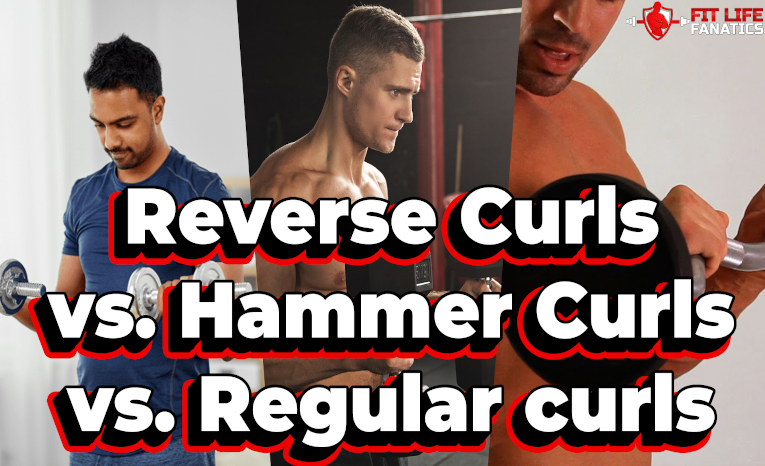Have you ever wondered whether reverse curls or hammer curls are more effective for targeting your biceps and forearms? Well, you’re not alone! Many fitness enthusiasts are curious about the differences between these two exercises and which one will give them better results.
In this article, we will explore the benefits and drawbacks of reverse curls and hammer curls, so you can make an informed decision about which exercise to incorporate into your workout routine.
When it comes to building strength and size in your biceps and forearms, both reverse curls and hammer curls have their own unique advantages. Reverse curls, as the name suggests, involve gripping the barbell or dumbbells with an overhand grip and curling your wrists upwards.
This exercise primarily targets the brachioradialis, a muscle in the forearm, while also engaging the biceps. On the other hand, hammer curls involve gripping the weights with a neutral or hammer-like grip, and curling the weights towards your shoulders.
This exercise works the brachialis, a muscle located underneath the biceps, as well as the brachioradialis and biceps. By incorporating both exercises in your workout routine, you can effectively target all the muscles in your biceps and forearms, leading to better muscular development and functional strength.
So, stay tuned to learn more about the specific benefits of reverse curls and hammer curls, and how you can incorporate them into your arm training routine.

Benefits of Reverse Curls
When it comes to building strong and defined biceps and forearms, there are several exercises that can help you achieve your goals. Two popular options are reverse curls and hammer curls. Each exercise offers its own unique benefits and targets different muscles in the arms. In this article, we will compare reverse curls and hammer curls, exploring their benefits, target muscles, proper techniques, variations, common mistakes, and how to choose the right variation for your goals.
Let’s start by examining the benefits of reverse curls. This exercise primarily targets the brachialis muscle, which lies underneath the biceps brachii. By performing reverse curls, you can develop more mass and strength in the brachialis, resulting in greater overall arm size and definition. Additionally, reverse curls also engage the biceps brachii and brachioradialis muscles, providing a well-rounded arm workout.
Benefits of Hammer Curls
On the other hand, hammer curls primarily target the brachialis and brachioradialis muscles, with less emphasis on the biceps brachii. The unique grip used in hammer curls, where the palms face each other throughout the movement, places greater stress on the brachioradialis muscle. This can help you build thicker forearms and develop the coveted “Popeye” look. Hammer curls also engage the biceps brachii, albeit to a lesser extent compared to reverse curls.

Muscles Targeted by Reverse Curls
Now let’s dive deeper into the specific muscles targeted by reverse curls. As mentioned earlier, the primary focus of this exercise is the brachialis muscle. Located underneath the biceps brachii, the brachialis plays a crucial role in elbow flexion. By performing reverse curls, you effectively isolate and strengthen the brachialis, leading to improved arm size and definition. Additionally, reverse curls also engage the biceps brachii and brachioradialis muscles to a lesser degree.
Muscles Targeted by Hammer Curls
Moving on to hammer curls, this exercise primarily targets the brachioradialis and brachialis muscles. The brachioradialis muscle runs along the forearm, from the upper arm to the wrist, and helps with forearm flexion. By performing hammer curls, you can effectively develop and strengthen this muscle, resulting in thicker and more defined forearms. Additionally, hammer curls also engage the biceps brachii, but to a lesser extent compared to reverse curls.

Proper Technique for Reverse Curls
To perform reverse curls correctly, follow these steps:
- Stand upright with a dumbbell in each hand, arms fully extended and palms facing down.
- Keep your upper arms stationary and exhale as you curl the weights upward, contracting your biceps.
- Pause for a moment at the top, squeezing your biceps.
- Inhale as you slowly lower the dumbbells back to the starting position, keeping your palms facing down throughout the movement.
- Repeat for the desired number of repetitions.
Proper Technique for Hammer Curls
For hammer curls, follow these steps:
- Stand upright with a dumbbell in each hand, arms fully extended and palms facing each other.
- Keep your upper arms stationary and exhale as you curl the weights upward, contracting your brachioradialis and brachialis muscles.
- Pause for a moment at the top, squeezing your forearms and biceps.
- Inhale as you slowly lower the dumbbells back to the starting position, keeping your palms facing each other throughout the movement.
- Repeat for the desired number of repetitions.

Variations of Reverse Curls
To add variety to your reverse curls routine, you can try the following variations:
- Barbell Reverse Curls: Instead of using dumbbells, use a barbell to perform reverse curls. This variation allows you to lift heavier weights and increase overall arm strength.
- Cable Reverse Curls: Attach a straight bar or rope handle to a cable machine and perform reverse curls. This variation provides constant tension throughout the movement, resulting in greater muscle activation.
- Resistance Band Reverse Curls: Place a resistance band under your feet and hold the other end with palms facing down. Perform reverse curls using the resistance provided by the band. This variation is great for home workouts or when you don’t have access to weights.
Variations of Hammer Curls
Similarly, you can incorporate these variations of hammer curls into your arm workout:
- Hammer Curls with Dumbbells: The classic hammer curl with dumbbells is an effective exercise on its own. Focus on maintaining proper form and gradually increasing the weights as you progress.
- Seated Hammer Curls: Perform hammer curls while seated on a bench. This variation helps stabilize your body and isolate the targeted muscles.
- Preacher Hammer Curls: Use a preacher bench to perform hammer curls. This variation provides added support and emphasis on the brachialis and brachioradialis muscles.

Common Mistakes in Reverse Curls
When performing reverse curls, it’s important to be aware of common mistakes to avoid:
- Using Momentum: Swinging or using momentum to lift the weights takes away the tension from the targeted muscles. Focus on controlled and deliberate movements.
- Flaring Elbows: Keep your elbows close to your torso throughout the movement. Flaring your elbows can put unnecessary stress on your shoulder joints and reduce the effectiveness of the exercise.
- Neglecting Form: Maintain a neutral wrist position and avoid excessive bending or extending of the wrists. This helps minimize the risk of injury and ensures proper muscle engagement.
Common Mistakes in Hammer Curls
When performing hammer curls, watch out for these common mistakes:
- Gripping Too Tight: Avoid gripping the dumbbells too tightly, as it can cause tension in the forearms and limit the range of motion.
- Relying on Shoulders: Ensure that your shoulders remain relaxed throughout the movement. Let your biceps and forearms do the work, not your shoulders.
- Swinging the Weights: Similar to reverse curls, avoid using momentum to swing or lift the weights. Focus on controlled movements to maximize muscle activation.
Choosing the Right Curl Variation for Your Goals
When deciding between reverse curls and hammer curls, consider your goals and how each exercise aligns with them. If your primary focus is developing bigger and more defined biceps, reverse curls may be the better option. On the other hand, if you want to target your forearms and achieve that “Popeye” look, hammer curls are the way to go.
Additionally, you can also incorporate both exercises into your arm workout routine for balanced development. Alternate between the two or perform them on different training days to ensure all target muscles are adequately trained.
Conclusion
In conclusion, both reverse curls and hammer curls offer unique benefits and target different muscles in the arms. Reverse curls primarily engage the brachialis, while hammer curls place greater emphasis on the brachioradialis. By incorporating variations and maintaining proper form, you can effectively build and strengthen your biceps and forearms.
Remember, consistency and gradual progression are key in achieving your desired results. So, whether you choose reverse curls, hammer curls, or a combination of both, stay dedicated and enjoy the journey of transforming your arms into strong and defined masterpieces.




